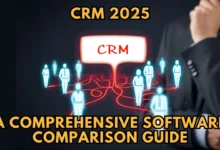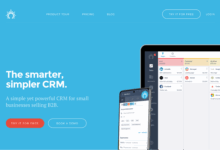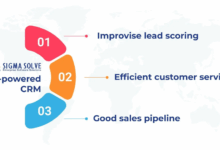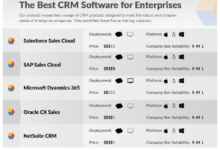Top Cloud-Based CRM Platforms: A Comprehensive Guide
Top Cloud-Based CRM Platforms represent a transformative shift in how businesses manage customer relationships. This guide delves into the advantages of cloud-based CRM solutions, comparing various deployment models and exploring the key features that define leading platforms like Salesforce, HubSpot, and Zoho CRM. We’ll examine crucial aspects such as integration capabilities, security protocols, and the process of selecting the ideal platform to meet specific business needs.
From understanding the core functionalities to navigating the complexities of data privacy and security, this comprehensive overview equips readers with the knowledge to make informed decisions when choosing a cloud-based CRM system. We will also explore real-world examples of successful CRM implementations across diverse industries, illustrating the tangible benefits these systems offer for growth and efficiency.
Introduction to Cloud-Based CRM Platforms
Cloud-based Customer Relationship Management (CRM) systems have revolutionized how businesses manage interactions with customers. They represent a significant shift from traditional, on-premise CRM solutions, offering increased flexibility, scalability, and cost-effectiveness. This section will explore the fundamentals of cloud-based CRM, highlighting its advantages and different deployment models.
Cloud-based CRM systems are software applications that are hosted on remote servers and accessed via the internet. Unlike on-premise systems, which require businesses to purchase, install, and maintain their own servers and software, cloud-based CRMs are managed by a third-party provider, eliminating the need for significant upfront investment and ongoing IT maintenance.
Advantages of Cloud-Based CRM over On-Premise Systems
Cloud-based CRM solutions offer several key advantages over their on-premise counterparts. These advantages contribute to increased efficiency, reduced costs, and improved customer relationship management. The most significant benefits include reduced infrastructure costs, enhanced accessibility, improved scalability, automatic updates, and higher security through specialized providers. Eliminating the need for extensive IT infrastructure significantly lowers upfront and ongoing expenses. Simultaneously, the accessibility offered by cloud solutions enables employees to access customer data from anywhere with an internet connection, boosting productivity and collaboration. Scalability is easily managed, allowing businesses to adjust their CRM capacity as their needs evolve. Finally, automatic updates ensure that the system always runs on the latest version, incorporating the newest features and security patches.
Types of Cloud-Based CRM Deployments
Cloud-based CRM systems are available in three primary deployment models: public, private, and hybrid. Each model offers a different level of control, security, and cost. Understanding these differences is crucial for selecting the best option for a specific business.
Comparison of Cloud-Based CRM Deployment Models
The following table summarizes the key features of each deployment model:
| Feature | Public Cloud | Private Cloud | Hybrid Cloud |
|---|---|---|---|
| Cost | Generally lower upfront costs, pay-as-you-go model | Higher upfront costs, predictable monthly expenses | Moderate upfront costs, flexible scaling |
| Security | Shared responsibility model, reliance on provider’s security measures | Higher level of control and security, dedicated infrastructure | Combines the security benefits of both public and private clouds |
| Scalability | Easily scalable, adaptable to changing business needs | Scalability can be limited by dedicated infrastructure | Highly scalable, combining the flexibility of both models |
| Customization | Limited customization options | Greater customization possibilities | Customization options vary depending on the mix of public and private cloud components |
Key Features of Top Cloud-Based CRM Platforms
Top cloud-based CRM platforms share a core set of functionalities designed to manage customer interactions and data effectively. Beyond these basics, however, advanced features differentiate leading platforms and cater to the specific needs of various businesses, from small startups to large enterprises. Understanding these key features is crucial for selecting the right CRM solution.
Core functionalities typically include contact management (storing and organizing customer information), lead management (tracking potential customers), sales management (managing the sales pipeline and opportunities), and reporting and analytics (providing insights into sales performance and customer behavior). These foundational elements form the backbone of any effective CRM system, enabling businesses to centralize customer data and streamline workflows.
Advanced Features in Cloud-Based CRMs
Advanced features significantly enhance the capabilities of basic CRM systems, boosting efficiency and providing deeper insights. AI-powered insights, for instance, leverage machine learning to analyze customer data and predict future behavior, enabling proactive sales and marketing strategies. Imagine a CRM that automatically identifies high-potential leads based on past purchase history and engagement patterns – this is the power of AI in action. Automation tools streamline repetitive tasks such as email marketing campaigns and follow-up calls, freeing up sales representatives to focus on building relationships. Finally, mobile accessibility allows sales teams to access and update customer information anytime, anywhere, improving responsiveness and collaboration.
Reporting and Analytics Capabilities
The reporting and analytics capabilities of different CRM platforms vary considerably. Some platforms offer basic reporting features, such as sales summaries and customer demographics. Others provide more advanced analytics, including predictive modeling, customer segmentation, and real-time dashboards. For example, Salesforce’s Einstein Analytics provides robust predictive capabilities, allowing businesses to forecast future sales and identify at-risk customers. Similarly, Microsoft Dynamics 365 offers comprehensive reporting and analytics tools, enabling users to create custom reports and dashboards tailored to their specific needs. The choice depends on the level of detail and sophistication required for business decision-making.
Essential Features for Different Business Sizes
The essential features of a CRM system can vary significantly depending on the size and needs of the business.
Below is a comparison of essential features for small businesses versus enterprise-level solutions:
- Small Businesses: Simple contact management, basic sales pipeline tracking, email integration, and affordable pricing are typically prioritized. Advanced features like AI-powered insights and complex reporting may not be immediately necessary.
- Enterprise-Level Solutions: These require more advanced features, including comprehensive contact management, sophisticated sales pipeline management, advanced analytics and reporting, integration with other enterprise systems (ERP, marketing automation), and robust security features to handle large volumes of data and complex workflows. AI-powered insights and automation are often crucial for optimizing efficiency and maximizing ROI.
Popular Cloud-Based CRM Platforms
Choosing the right cloud-based CRM platform is crucial for business success. The market offers a diverse range of options, each with its own strengths and weaknesses. This section provides a comparative analysis of five leading platforms to aid in informed decision-making. We will examine pricing, features, scalability, and user experiences to offer a comprehensive overview.
Popular Cloud-Based CRM Platform Comparison
The following table compares five popular cloud-based CRM platforms: Salesforce, HubSpot, Zoho CRM, Microsoft Dynamics 365, and Pipedrive. This comparison considers factors vital for businesses of varying sizes and needs.
| Feature | Salesforce | HubSpot | Zoho CRM | Microsoft Dynamics 365 | Pipedrive |
|---|---|---|---|---|---|
| Pricing Model | Subscription-based, various editions with different features and user limits. Pricing varies greatly depending on the edition and number of users. | Freemium model with paid options offering increased features and user capacity. Pricing scales with the number of users and features needed. | Subscription-based, multiple editions with tiered pricing. Offers a free plan with limited functionality. | Subscription-based, various plans with different functionalities and user limits. Pricing is dependent on the chosen plan and number of users. | Subscription-based, tiered pricing model with varying features and user limits. Pricing is generally more affordable than Salesforce or Microsoft Dynamics 365. |
| Scalability | Highly scalable, suitable for businesses of all sizes, from startups to large enterprises. | Scalable, suitable for growing businesses, but may require more complex configurations for very large enterprises. | Scalable, suitable for small to medium-sized businesses. Scalability for large enterprises may present some challenges. | Highly scalable, designed to handle large volumes of data and users, ideal for large enterprises. | Scalable, suitable for small to medium-sized businesses. Scaling to very large enterprises might require careful planning. |
| Integration Capabilities | Extensive integration capabilities with various third-party applications through its AppExchange. | Strong integration capabilities with other HubSpot tools and a wide range of third-party applications. | Good integration capabilities, though the range of integrations may be less extensive than Salesforce or HubSpot. | Extensive integration capabilities with other Microsoft products and a range of third-party applications. | Good integration capabilities with popular business tools, although the breadth might be less compared to market leaders. |
| Customer Support | Offers various support options, including phone, email, and online resources. Generally considered robust, but can be costly. | Offers comprehensive support resources, including documentation, community forums, and paid support plans. | Provides email and phone support, with varying levels of responsiveness depending on the subscription tier. | Offers multiple support channels, including phone, email, and online resources. Support quality is generally considered good. | Provides email and online support resources, with a generally responsive community forum. |
| Strengths | Highly customizable, powerful automation features, extensive app ecosystem. | Strong inbound marketing tools, easy-to-use interface, robust analytics. | Affordable pricing, wide range of features, good value for money. | Seamless integration with other Microsoft products, robust security features, strong enterprise capabilities. | Intuitive interface, focus on sales pipeline management, affordable pricing. |
| Weaknesses | Steep learning curve, complex interface, can be expensive. | Limited customization options in the free plan, may require additional tools for advanced functionalities. | Can feel overwhelming for users with limited technical expertise, customer support might be less responsive compared to premium options. | Can be complex to implement and configure, requires technical expertise. | Limited customization options, fewer integrations compared to leading platforms. |
Integration Capabilities and Ecosystem
A robust CRM’s value extends far beyond its core contact management functions. Seamless integration with other business tools is crucial for optimizing workflows, automating processes, and gaining a holistic view of customer interactions. The ability to connect a CRM to marketing automation platforms, email marketing services, accounting software, and other applications significantly enhances efficiency and data accuracy. This section explores the importance of CRM integration, common integration methods, successful integration examples, and the ecosystems surrounding leading cloud-based CRM platforms.
The importance of integrating a CRM with other business tools cannot be overstated. Connecting disparate systems eliminates data silos, reduces manual data entry, and prevents inconsistencies. This unified data flow allows for a more comprehensive understanding of customer behavior, enabling businesses to personalize interactions and improve customer satisfaction. For instance, a marketing campaign launched through a marketing automation platform can be directly tracked within the CRM, providing insights into lead generation and conversion rates. Similarly, sales data from the CRM can be automatically fed into accounting software, streamlining financial reporting.
Integration Methods
Several methods facilitate the integration of CRMs with other applications. Application Programming Interfaces (APIs) provide a standardized way for different software systems to communicate and exchange data. Connectors, often pre-built integrations provided by either the CRM vendor or third-party developers, simplify the connection process by offering pre-configured links between specific applications. Custom integrations, developed by skilled programmers, offer maximum flexibility but require more technical expertise and resources. The choice of integration method depends on the technical capabilities of the organization and the specific needs of the integration.
Examples of Successful CRM Integrations
A successful integration between Salesforce and Marketo, a marketing automation platform, allows marketing teams to track campaign performance, segment audiences based on CRM data, and personalize marketing messages. The automated synchronization of contact data ensures that marketing efforts are targeted and effective. Another example is the integration of a CRM like HubSpot with Xero, an accounting software. This allows for automatic recording of invoices and payments, simplifying financial processes and providing real-time financial insights related to sales activities. Such integrations enhance efficiency and accuracy across departments.
Ecosystems of Apps and Extensions
Leading cloud-based CRM platforms boast extensive ecosystems of apps and extensions, enhancing their functionality and adapting them to diverse business needs. Salesforce AppExchange, for example, offers thousands of apps developed by independent software vendors (ISVs), providing specialized functionalities for various industries and business processes. Similar app marketplaces exist for other platforms like Microsoft Dynamics 365 and HubSpot, providing users with a wide range of options to customize their CRM systems to meet specific requirements. These ecosystems foster innovation and enable businesses to tailor their CRM solutions to their unique operational needs.
Security and Data Privacy Considerations
Choosing a cloud-based CRM involves careful consideration of security and data privacy. The sensitive nature of customer data necessitates robust security measures from providers. This section details the security practices of leading platforms and explores the implications for data protection.
Data Encryption and Access Controls
Leading cloud-based CRM providers employ multiple layers of security to protect customer data. Data encryption, both in transit (using HTTPS) and at rest (using encryption at the database level), is a standard practice. This ensures that even if data is intercepted, it remains unreadable without the appropriate decryption key. Access controls are implemented through role-based permissions, allowing administrators to granularly define user access rights. This prevents unauthorized access and modification of data. Multi-factor authentication (MFA) is also frequently offered, adding an extra layer of security to user logins.
Compliance Certifications and Data Privacy Policies
Compliance with various data privacy regulations is crucial. Many top CRM platforms boast certifications such as ISO 27001 (information security management), SOC 2 (service organization controls), GDPR (General Data Protection Regulation), and HIPAA (Health Insurance Portability and Accountability Act). These certifications demonstrate a commitment to meeting industry best practices for data security and privacy. Individual platform data privacy policies outline how customer data is collected, used, and protected. These policies often detail data retention periods, data transfer practices, and procedures for data subject requests (e.g., access, correction, deletion). Careful review of these policies is essential before selecting a CRM platform.
Comparison of Security Features Across Platforms
The following table summarizes the security features of some popular cloud-based CRM platforms. Note that specific features and certifications may vary depending on the chosen plan or service level.
| Platform | Data Encryption (at rest/in transit) | Access Controls | Key Compliance Certifications |
|---|---|---|---|
| Salesforce | AES-256 encryption (at rest and in transit) | Role-based access control, permission sets | ISO 27001, SOC 2, GDPR, HIPAA |
| Microsoft Dynamics 365 | AES-256 encryption (at rest and in transit) | Role-based access control, security roles | ISO 27001, SOC 2, GDPR, HIPAA |
| HubSpot | AES-256 encryption (at rest and in transit) | User-based permissions, team access controls | ISO 27001, SOC 2 |
| Zoho CRM | AES-256 encryption (at rest and in transit) | Role-based access control, profile-based permissions | ISO 27001, SOC 2 |
Choosing the Right Cloud-Based CRM Platform
Selecting the optimal cloud-based CRM platform is crucial for business success. The right system streamlines operations, improves customer relationships, and ultimately drives revenue growth. However, choosing the wrong one can lead to wasted resources and decreased efficiency. A careful evaluation process, considering various factors, is essential.
Factors Influencing CRM Platform Selection
Several key factors must be considered when choosing a cloud-based CRM. These factors directly impact the platform’s effectiveness and suitability for a specific business. Ignoring these could lead to a poor fit and ultimately hinder business growth.
- Business Size: Small businesses may benefit from simpler, more affordable platforms with limited features, while large enterprises require scalable solutions with advanced functionalities and robust integrations. For instance, a small startup might find a platform like HubSpot CRM sufficient, whereas a multinational corporation might need a more comprehensive solution like Salesforce Sales Cloud.
- Budget: CRM platforms range significantly in price, from free options with limited capabilities to enterprise-level solutions costing thousands of dollars per month. A thorough budget analysis is crucial to determine the appropriate investment level. Consider not only the initial cost but also ongoing maintenance, support, and potential add-on expenses.
- Industry: Specific industries have unique requirements. A CRM for a healthcare provider will differ significantly from one used by a manufacturing company. Consider industry-specific features, compliance requirements (like HIPAA for healthcare), and integrations with relevant industry tools.
- Specific Needs: Businesses must identify their precise needs before selecting a platform. These needs might include sales force automation, marketing automation, customer service management, or a combination of these. Clearly defining these needs helps narrow down the options and focus on platforms that address them effectively.
Step-by-Step Guide for Evaluating CRM Platforms
A structured approach to evaluating different CRM platforms ensures a thorough assessment and informed decision. This systematic process minimizes the risk of selecting an unsuitable system.
- Define Requirements: Clearly articulate your business needs, including desired functionalities, integrations, and reporting capabilities. This detailed list acts as a benchmark for evaluating potential platforms.
- Research and Shortlist: Identify potential CRM platforms based on your requirements and budget. Use online reviews, industry reports, and vendor websites to gather information.
- Request Demos and Trials: Most vendors offer demos or free trials. Utilize these opportunities to test the platform’s usability, features, and integration capabilities within your specific workflow.
- Compare Features and Pricing: Create a comparison table outlining the key features, pricing models, and limitations of each shortlisted platform. This allows for a direct comparison and identification of the best fit.
- Assess Integrations: Verify the platform’s ability to integrate with your existing systems (e.g., email marketing platforms, accounting software). Seamless integration is crucial for efficient data flow and improved productivity.
- Check Customer Support and Documentation: Reliable customer support and comprehensive documentation are essential for ongoing success. Evaluate the vendor’s support options and the availability of helpful resources.
- Make a Decision: Based on your evaluation, choose the platform that best meets your requirements, budget, and long-term goals.
Assessing Scalability and Future-Proofing
Scalability and future-proofing are critical considerations when selecting a CRM. Choosing a platform that can adapt to your business’s growth and technological advancements ensures long-term value.
Scalability refers to the platform’s ability to handle increasing data volumes, user accounts, and functionalities as your business expands. A scalable CRM can adapt to changing needs without requiring a complete system overhaul. For example, a cloud-based CRM can easily scale up resources (storage, processing power) as needed, unlike on-premise solutions which often require significant infrastructure upgrades.
Future-proofing involves selecting a platform that can adapt to evolving technologies and industry trends. Consider platforms with open APIs, regular updates, and a strong track record of innovation. Choosing a platform known for its consistent updates and integrations with emerging technologies ensures the CRM remains relevant and efficient in the long term. For example, a CRM with robust AI capabilities will likely be more adaptable to future automation trends than one without such features.
CRM Platform Evaluation Checklist
This checklist provides a structured framework for evaluating potential CRM platforms. Using this checklist ensures that all crucial aspects are considered before making a decision.
| Criterion | Rating (1-5) | Notes |
|---|---|---|
| Functionality | ||
| Usability | ||
| Scalability | ||
| Integrations | ||
| Security | ||
| Pricing | ||
| Customer Support | ||
| Vendor Reputation |
Case Studies
Successful CRM implementations demonstrate the transformative power of these systems across diverse industries. Examining these case studies reveals common challenges, effective solutions, and key factors contributing to overall success. This analysis provides valuable insights for organizations considering CRM adoption.
Case Study: Increased Sales Efficiency at a Retail Chain
This national retail chain, specializing in home goods, implemented a cloud-based CRM to address declining sales conversion rates and inconsistent customer service. Prior to the CRM implementation, sales data was fragmented across multiple systems, making it difficult to track customer interactions and personalize the shopping experience. The company faced challenges in data integration, requiring significant effort to consolidate data from disparate sources. The solution involved migrating all customer data into a centralized CRM system, integrating it with their point-of-sale system and e-commerce platform. This enabled sales associates to access a complete view of each customer’s purchase history, preferences, and interactions. The result was a 15% increase in sales conversion rates within the first year, attributed to improved personalization and targeted promotions. Key factors contributing to this success included robust training for sales staff, a clearly defined implementation plan, and ongoing support from the CRM vendor.
Case Study: Enhanced Customer Retention in the Financial Services Sector
A regional bank implemented a cloud-based CRM to improve customer retention and enhance personalized financial advice. The bank struggled with maintaining consistent communication with customers and lacked a centralized system to track customer interactions and preferences. The challenge was in integrating legacy systems with the new CRM and ensuring data security and compliance. The solution involved a phased implementation, starting with a pilot program in a specific branch. The CRM integrated with the bank’s core banking system, allowing customer service representatives to access a complete view of each customer’s financial profile. This enabled them to provide more personalized advice and proactive service, resulting in a 10% reduction in customer churn within two years. Key success factors included strong leadership support, effective change management strategies, and a focus on user adoption.
Case Study: Streamlined Operations in a Manufacturing Company
A medium-sized manufacturing company implemented a cloud-based CRM to improve communication and collaboration across different departments, specifically between sales, marketing, and customer support. The company faced challenges in tracking leads, managing customer interactions, and ensuring consistent messaging across all channels. The solution involved integrating the CRM with their manufacturing execution system (MES) to provide a complete view of the entire customer lifecycle, from initial contact to product delivery and post-sales support. This improved visibility into the entire process, enabling faster response times to customer inquiries and more efficient problem resolution. The implementation resulted in a 20% reduction in customer service response time and a 10% increase in customer satisfaction. Key factors for success included careful selection of the CRM system based on the company’s specific needs, thorough training for employees, and a strong focus on data quality.
Closing Notes
Ultimately, selecting the right cloud-based CRM platform is a strategic decision that demands careful consideration of various factors. This guide has provided a framework for understanding the key features, deployment options, and integration capabilities of leading platforms. By weighing the strengths and weaknesses of each solution against your specific business requirements, you can confidently choose a CRM system that will optimize your customer interactions and drive sustainable growth. Remember to prioritize security, scalability, and seamless integration with existing business tools for a truly impactful implementation.






